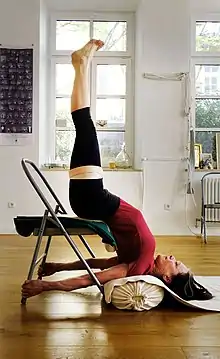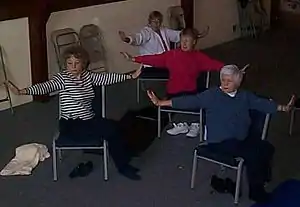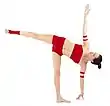Yoga using props
Props such as chairs, blocks, belts, blankets and bolsters are used in postural yoga to assist with correct alignment in an asana, and to enable people with movement restricted for any reason, such as stiffness, injury, or arthritis, to continue with their practice.

Similar techniques may be used in yoga as therapy, with the intention of alleviating conditions such as low back pain. The approach has been explored in the attempt to treat specific medical conditions such as arthritis, but it has not been found to be effective for this purpose.
For correct alignment

Chairs and other props are used widely in some schools of modern yoga as exercise, such as Iyengar Yoga, to enable students to work with correct alignment in more advanced asanas with suitable support.[1] Iyengar Yoga was created by B. K. S. Iyengar, a pupil of the yoga pioneer Tirumalai Krishnamacharya, and described in his authoritative 1966 book Light on Yoga.[3] The scholar of religion Andrea Jain observes that the book "prescribed a thoroughly individualistic system of postural yoga",[4] one that was "rigorous and disciplined",[4] requiring props such as "belts, bricks, and ropes".[4]
For example, in Iyengar Yoga, Sarvangasana, shoulder stand, can be practised under suitable supervision with the shoulders on a bolster, the buttocks supported on the seat of a chair and a blanket, and the legs resting on the top of the chair's back.[2]
For restricted movement
Yoga as therapy is the use of asanas as a gentle form of exercise and relaxation, applied specifically with the intention of improving health. This may involve meditation, imagery, breath work (pranayama) and music alongside the exercise.[5]
Alice Christensen's Easy Does It Yoga, first described in 1979, uses "chair exercises", alongside others on floor or bed, and in later editions also in swimming pools or reclining on beds or the floor, for older practitioners with restricted movement.[6][7]

Lakshmi Voelker-Binder created an approach named Chair Yoga in 1982, on seeing that one of her pupils, aged only in her thirties, was unable to do floor poses because of arthritis.[8] Lynn Lehmkuhl described Chair Yoga as the fastest growing aspect of the yoga market in 2013, prompting her to take a yoga teacher training with Voelker-Binder.[9]
A 2013 systematic review found beneficial effects of yoga on low back pain.[10]
See also
References
- Shifroni, Eyal (2013). A chair for yoga : a complete guide to Iyengar Yoga practice with a chair. CreateSpace. p. 3 and whole book. ISBN 978-1-4952-9685-7. OCLC 907684979.
- Mehta, Silva; Mehta, Mira; Mehta, Shyam (1990). Yoga: The Iyengar Way. Dorling Kindersley. pp. 118–119. ISBN 978-0863184208.
- Goldberg, Michelle (23 August 2014). "Iyengar and the Invention of Yoga". The New Yorker. Retrieved 20 November 2018.
- Jain, Andrea (July 2016). "The Popularization of Modern Yoga". Oxford Research Encyclopedias. doi:10.1093/acrefore/9780199340378.013.163. Retrieved 20 March 2019.
- Feuerstein, Georg (2006). Jonathan Shear (ed.). The Experience of Meditation. St. Paul, Minnesota: Paragon House. p. 90.
- Christensen, Alice (1979). Easy Does It Yoga for Older People. San Francisco and Cleveland: Harper and Row; Light of Yoga Society.
- Christensen, Alice (1999). The American Yoga Association's Easy Does It Yoga: the safe and gentle way to health and well-being. New York: Fireside Book. pp. 63–91 and throughout. ISBN 978-0-684-84890-7. OCLC 41951264.
- "About Lakshmi Voelker". Get Fit Where You Sit. Retrieved 8 April 2019.
- Lehmkuhl, Lynn (2020). Chair Yoga for Seniors : stretches and poses that you can do sitting down at home. New York, NY: Skyhorse Publishing. Introduction. ISBN 978-1-5107-5063-0. OCLC 1134762765.
- Cramer, Holger; Lauche, Romy; Haller, Heidemarie; Dobos, Gustav (2013). "A Systematic Review and Meta-analysis of Yoga for Low Back Pain". The Clinical Journal of Pain. 29 (5): 450–460. doi:10.1097/AJP.0b013e31825e1492. PMID 23246998.
